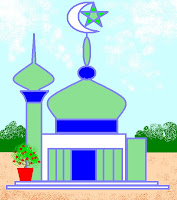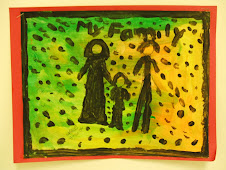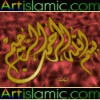Wednesday, January 23, 2008
Friday, January 18, 2008
One Point Perspective
One Point Perspective is when one vanishing point is used.

Step One: Draw a line border around your page/paper.
 Step Two: Draw a horizontal line (blue line)across the top part of your paper.
Step Two: Draw a horizontal line (blue line)across the top part of your paper.

Step Four: Draw a square in the lower left hand side of your paper.
 Step Five: Draw lines (green lines)to the three corners of the square. These are construction lines.
Step Five: Draw lines (green lines)to the three corners of the square. These are construction lines. Step Six: Draw parallel lines (orange lines) to make two sides of the cube. now you should be able to see a cube. If your lines are not parallel the shape will be distorted.
Step Six: Draw parallel lines (orange lines) to make two sides of the cube. now you should be able to see a cube. If your lines are not parallel the shape will be distorted. Step Seven: Now you can add color. It is important to use color in three values or shades. The square will have the darkest color because it is the closest to you. In perspective, the object or the part of the object that is the closet to you is the darkest color. Next the top will be the lightest because it is the most exposed part. and the remaining will be the middle shades.
Step Seven: Now you can add color. It is important to use color in three values or shades. The square will have the darkest color because it is the closest to you. In perspective, the object or the part of the object that is the closet to you is the darkest color. Next the top will be the lightest because it is the most exposed part. and the remaining will be the middle shades. Step Eight: To make the cube really look 3D you will have to add a shadow. In this case you can see that light is coming from the vanishing point so you will be adding the shadow from that point. Draw the shadow lines. (grey lines) Notice that one shadow line continues from one green line or one side of the cube and the other actually passes through the other corner/ angle of the cube.
Step Eight: To make the cube really look 3D you will have to add a shadow. In this case you can see that light is coming from the vanishing point so you will be adding the shadow from that point. Draw the shadow lines. (grey lines) Notice that one shadow line continues from one green line or one side of the cube and the other actually passes through the other corner/ angle of the cube.
Step Nine: fill in the shadow area with a medium shade of grey.
 Step Ten: Erase or delete all construction lines except for the horizontal line. Attend to details and make sure all your lines are straight and colors are well placed.
Step Ten: Erase or delete all construction lines except for the horizontal line. Attend to details and make sure all your lines are straight and colors are well placed. Step Eleven: Put in your background color which would be light and your foreground color which would be dark.
Step Eleven: Put in your background color which would be light and your foreground color which would be dark. Monday, January 14, 2008
Art brings Muslim, Jewish students together
They complied artworks for an exhibition “Coexistence Through Art" held on Nov. 27 at the Addison-Penzak Jewish Community Center, 14855 Oka Road in Los Gatos.
They are trying to get out the message of coexistence. They feel that it is the future and that we can work things out in the Middle East if we can respect each other.
It is a wonderful endeavor and commendable indeed.
Tuesday, January 8, 2008
Al-Aqsa Masjid

Many may think that Art education is a waste of time in Islamic schools. However art education does not only teach creativity and inventiveness but also culture, history and general knowledge.
After all can you tell which of the two pictures above shows the Al-Aqsa Masjid?
Which did you choose? The one on the right is not and is actually thought to be the Al-Aqsa Masjid by a lot of Muslims while the actual Masjid is shown on the left. The one on the right is actually the Qubat As-Sakhra Masjid.
Knowledge is power and depriving our children of any type can be more devastating that you think.

Monday, January 7, 2008
Islamic school of Art

Muslims follow Madhhab; these are Islamic school of thought or (figh) religious jurisprudence. There are four; the Hanafi, the Maliki, the Shafi’i and the Hanbali.
In the art world there are also schools of art according to style or a movement as belonging a particular group of artists. These artists have a common influence or origin. It is not a physical school but reflects the style of art around that time.
Islamic art is not easily recognizable because Muslims vary from nation to nation except if it is traditional in nature; e.g. Arabic calligraphy or the architecture of a Masjid.
But the one feature which would indeed unify Muslim artists would be the belief that to draw realistic images of people and animals are forbidden. Also not only to create these images but also the way that they are used. Still with the vast array of media and medium it would be difficult for all contemporary Islamic art to look the same. My guess is that it would also reflect the culture of the artist, his style, the medium he uses, the influences which are endless and so much more.
It would be extremely interesting to see what an actual Islamic Art School would be like. Well there's a link to a traditional school .
http://www.psta.org.uk/index.php?n=Main.Homepage
This one in Pakistan seems more secular than Islamic.
http://www.nca.edu.pk/index.htm
Friday, January 4, 2008
Islamic Art teaches Math

Many Islamic artistic expressions were done in intricate patterns and exquisite geometric designs. Math is the tool that is used to create such beautiful eyefuls.Today many are using this most famous aspect of Islamic art to teach algebra, geometry and calculus of Math in classrooms and colleges. It provides an exciting medium to an otherwise “boring” topic. Radial, symmetry and tessellation can provide an easy way for students to learn about these concepts in Math.
You can check out this book;Geometric Concepts in Islamic Art (Paperback)by Issam El-Said (Author), Ayse Parman (Author)
Links to check out how it is done.1. http://www.collegenews.org/x4595.xml2. http://homeschoolmath.blogspot.com/2007/02/geometric-patterns-in-islamic-art.html3. http://www.mtholyoke.edu/offices/comm/news/summermath.shtml4. http://www.artteacherconnection.com/pages/anrtandmath.htm5. http://mtcs.truman.edu/~thammond/history/Art.html6. http://www.vam.ac.uk/school_stdnts/schools_teach/teachers_resources/maths/index.html
Thursday, January 3, 2008
Prayer Mats
 Images can be very influential and no where is that more obvious than when I am praying. First I make sure that my environment is clean, I make wudu, check my clothes to see if they are clean and cover me well. Then I lay down my prayer mat and pray. Easy right?
Images can be very influential and no where is that more obvious than when I am praying. First I make sure that my environment is clean, I make wudu, check my clothes to see if they are clean and cover me well. Then I lay down my prayer mat and pray. Easy right?Well sometimes concentrating can be hard and ever so often my mind wonders, especially if my kids are around. But even before I had kids, work and a job there was something that bothered me some what. You see, when I am looking down and trying to think about my Lord, the prayer mat stares back at me! And it might not be a pretty face I see.
Am I nuts? Mats with eyes? Well…at first I felt a bit funny. Growing up we prayed on a large soft brown carpet with no designs. But as I got older and would sometimes pray by myself I would use the prayer mats made for one person. These mats have a lot of designs. The designs do not have realistic images of people or animals. In fact the designs are mostly of Islamic themes and pictures. These pictures might have the Kaaba or a holy place.
The thing is that when one stares long enough at these mats one can actually see faces. These “faces” usually make “ugly looks” and would sometimes make me jump. But now I don’t have that problem. I have found that it used to bother me. Alhamduillah now I just have to concentrate on my prayer and not the imaginative "creatures" staring at me. I see enough of that when I look in the mirror.
Wednesday, January 2, 2008
AerosolArabic

http://www.aerosolarabic.com/v2/index.php
He has been creating murals in the Us but he is from England and is working hard there and Europe to promote Arabic calligraphy through an unlikely media; graffiti. A sure way to touch the man in the street. I wish that my students would be able to interact with him. They would be so motived like I am.
Tuesday, January 1, 2008
Zarah Hussain

Zarah Hussain is from Pakistan. She paints simple yet elaborate works of art using simple geometric shapes to form intricate designs and patterns. She is exhibiting her work at the Walthamstow gallery until the end of this month, January, 2008.
As I don’t live in London I cannot view her art in exhibit. But never the less I can enjoy her work from a “distance”.
From her websitehttp://www.zarahhussain.co.uk/ I can tell that she embodies her belief in her art and certainly can be an example for many to follow. I really am impressed with her designs and inspired by her talent.
Drawing the Kaaba

Step one - Draw a line across the bottom half of your paper. This your horizon line. It separates the foreground from the background.
Step Two - Draw a square making sure that most of the shape is above the horizon line.  Step Three -Draw another square behind square number one, making sure that it finished below the horizon line and a little to the side.
Step Three -Draw another square behind square number one, making sure that it finished below the horizon line and a little to the side.
 Step four - Now join the two squares by drawing straight lines (red lines) from the four corners.
Step four - Now join the two squares by drawing straight lines (red lines) from the four corners. Step Five -Draw four more straight lines (red lines). Two on the square number one and two on the side facing you in a slight angle.
Step Five -Draw four more straight lines (red lines). Two on the square number one and two on the side facing you in a slight angle. Step six - To add the background, start by adding two horizontal lines (green lines) and drawing the tower.
Step six - To add the background, start by adding two horizontal lines (green lines) and drawing the tower. Step seven - Next to draw the arches, draw some vertical lines (green lines).
Step seven - Next to draw the arches, draw some vertical lines (green lines). Step eight - To complete the arches draw some slightly curved lines ( blue lines)
Step eight - To complete the arches draw some slightly curved lines ( blue lines) Step nine -You are ready to color. Color square number one with black leaving the space between the two red lines blank. Color the top space in a light brown or any other light color. Color the side in a medium grey. Color the band around the Kaaba in yellow.
Step nine -You are ready to color. Color square number one with black leaving the space between the two red lines blank. Color the top space in a light brown or any other light color. Color the side in a medium grey. Color the band around the Kaaba in yellow. 








